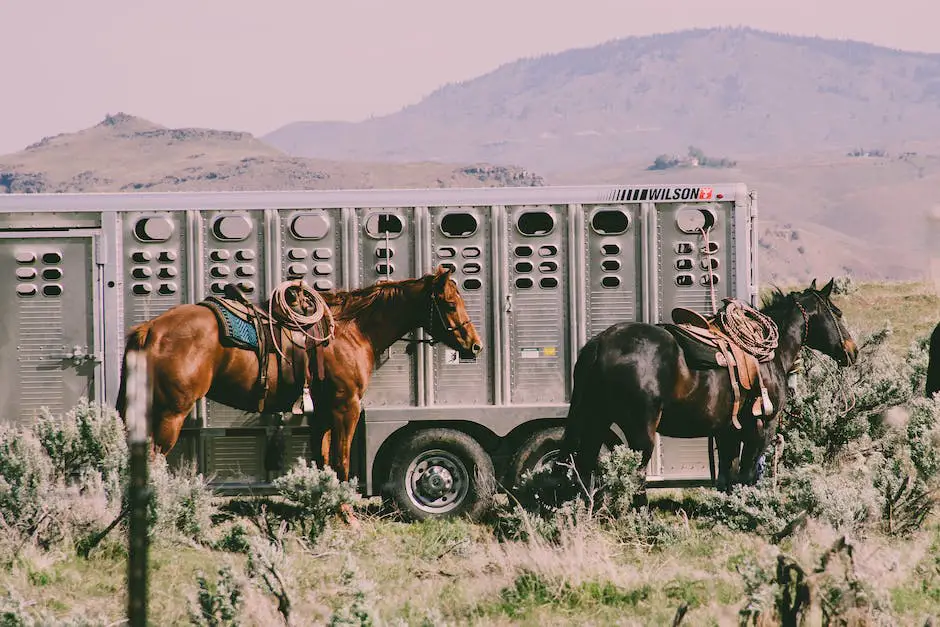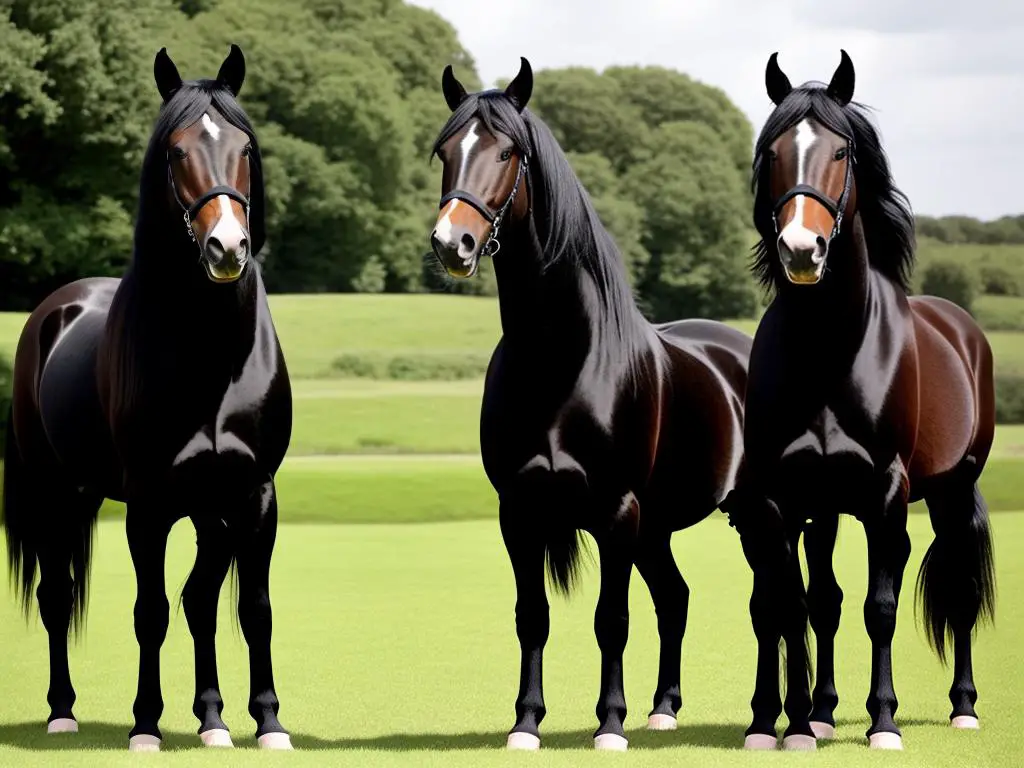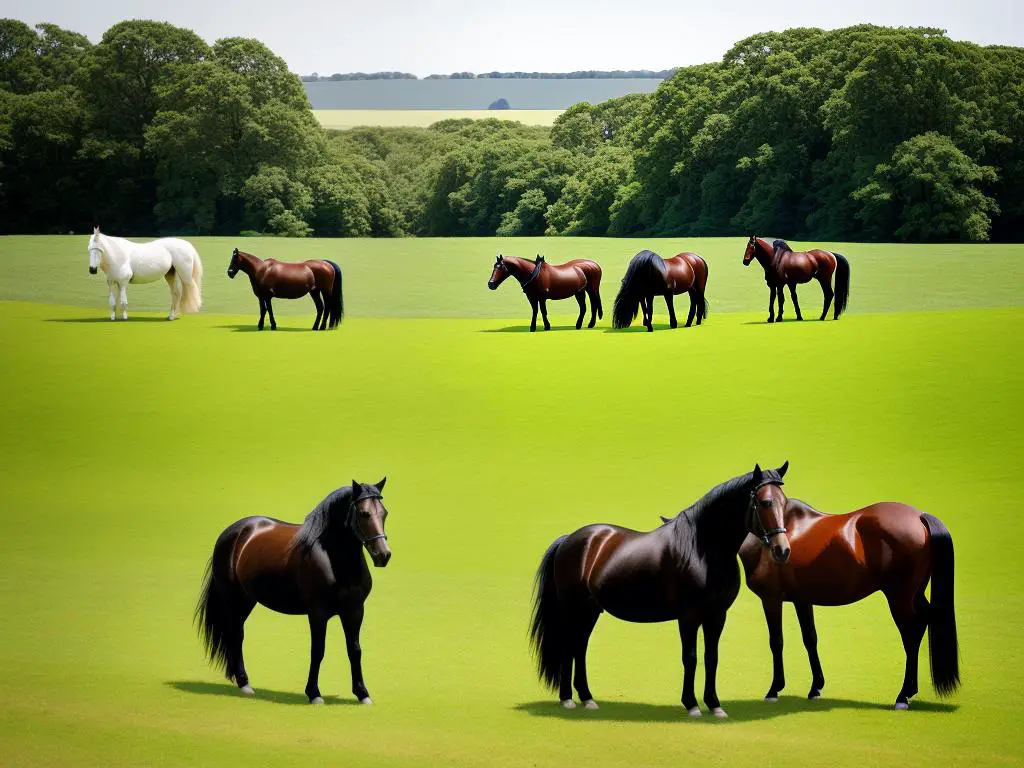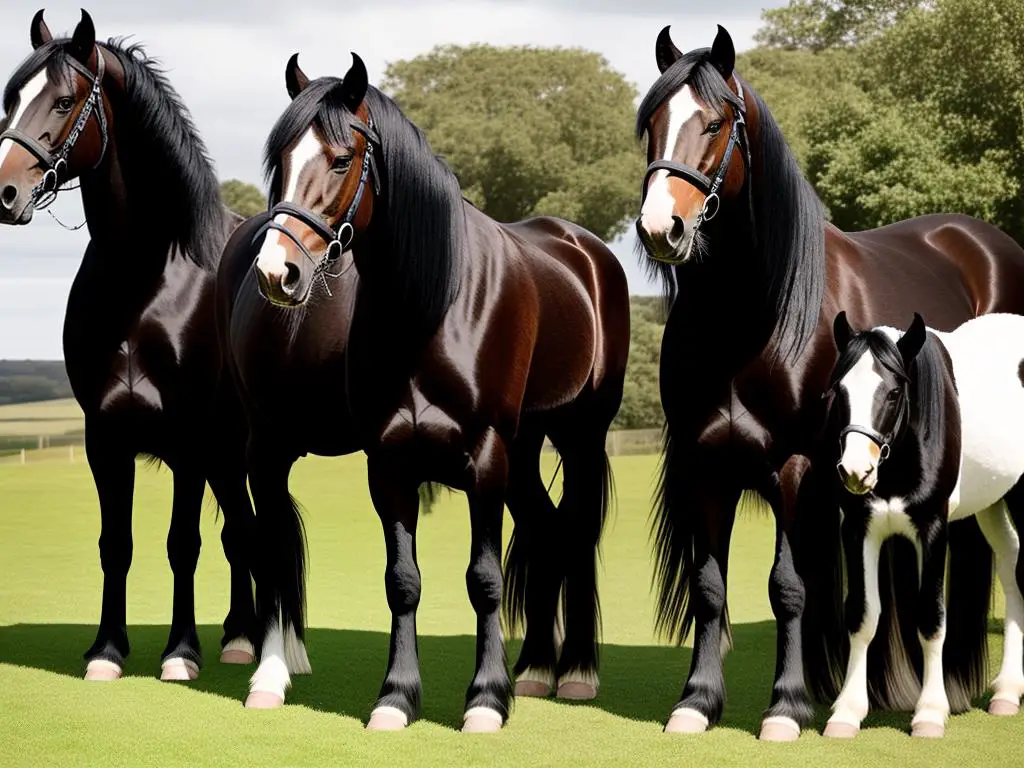The Shire and Friesian horses, revered for their strength, beauty, and distinct traits, boast rich histories that echo the geographical landscapes that nurtured them. Originating from divergent corners of Europe, both breeds have sculpted histories intertwined with human activities, each bearing different characteristics, uses, and temperaments. The Shire, a British breed, known for its sheer size, strength, and gentle personality, was instrumental in shaping traditional agriculture. On the other hand, we have the Friesian horse, an elegant Dutch breed, marked by its shimmering black coat and agile movements, often a spectacle in performances and shows. As we embark on this exploration, we will delve into their distinctive attributes, offering a comprehensive understanding of their physical features, personalities, temperaments, and abilities, providing insights to prospective owners and horse enthusiasts alike.
Table of Contents (Horspedia)
Overview of Shire and Friesian Horses
Shire Horses: A Historical Overview
Shire horses, originating from the United Kingdom, have a rich history dating back to medieval times. They were initially bred for carrying heavy loads and armored knights into battle. Over time, they transitioned to working on farms and pulling heavy hauls. Shire horses are known for their incredible strength, calm temperament, and tall stature, with an average height ranging from 17 to 19 hands (68 to 76 inches). They hold the record for being the tallest horse breed in the world.
Shires typically have a black, bay, or gray coat complemented by long, feathered hair at their lower legs. Their distinguishing characteristics include a large, broad head with large eyes, a somewhat Roman nose, and a long, flowing mane and tail. They are well-respected for their hardiness, docility, and willingness to work, making them a favorite workhorse in various fields even until today.
Their distribution remains strong in their native region, the United Kingdom. However, Shire horses can also be found in other parts of the world such as the United States and Australia, primarily due to these countries’ agricultural histories.
Friesian Horses: A Historical Overview
Friesians, on the other hand, hail from Friesland in the Netherlands. Named after their place of origin, this breed is characterized by its striking, ebony coat and its graceful, high-stepping gait. The Friesian breed dates back to the Roman times and has been consistently revered for its versatility – serving in war, farming, and carriage work.
Friesians, on average, stand between 15 to 17 hands (60 to 68 inches) high. They showcase a muscular build, a thick mane and tail, and a beautiful arched neck. Their coat is most commonly pure black, although rare chestnut variations can occur. Friesians are admired for their agility, elegance, and light-hearted approach to hard work. They are often seen in dressage, carriage driving, and even in the film industry due to their unique beauty and trainable nature.
Like Shires, Friesians possess a significant presence in their country of origin, the Netherlands. The popularity of Friesians has extended internationally due to their unique aesthetics and versatility, and they can now be found in many corners of the globe, including North America and Europe.
Comparing Shire and Friesian Horses
The strength, hard work, and beauty shared by the Shire and Friesian horse breeds are nothing short of commendable. Despite these similarities, each breed shines uniquely in different fields. For instance, Shires, due to their substantial size, are often seen in heavy-duty tasks like pulling large loads or agricultural work. The equanimity of their disposition makes them a suitable choice for handlers with varying degrees of experience.
In contrast, Friesians display an unmatched grace and elegance that make them an absolute showstopper in competition arenas. Their noticeable high-stepping gait, coupled with their sleek black coats, establish their visibility in any crowd. Due to their agility and sporty physique, they have proven their competence in an array of equestrian disciplines, dressage being a notable example.
Both breeds originated from Europe, but their distinct qualities and capabilities have garnered them an international following. Regardless of their contrasting lineages and characteristics, the Shire and Friesian horses are emblematic of the incredible strength and beauty horse breeds can possess.

Physical Characteristics
An Overview of Shire Horse’s Physical Traits
Ranked among the tallest and heaviest breed globally, the Shire horse is indeed an impressive sight to behold. Male Shires typically stand from 17 to 19 hands (equivalent to 68 to 76 inches) tall, while females are typically between 16 and 17 hands (or 64 to 68 inches) tall. On average, they weigh between 1,800 to 2,400 pounds, although some may weigh more.
Shire horses showcase a variety of coat colors, including black, bay, and gray. Though rarer, some do display roan or chestnut coats. The long and flowing hair, also known as “feathers,” adorns their lower legs, lending the breed a distinct look. These feathers are usually white, contrasting with the darker color of their body coat.
The Shire horse’s physical characteristics are typified by its gigantic stature, forceful build, and classic draft horse look. Their broad foreheads, large eye size, and linear profile complement their strong neck and sturdily-built legs, making them a living testament to extraordinary strength and endurance.
Physical Characteristics of Friesian Horse
The Friesian horse, native to the Netherlands, is also a large breed, although not as large as the Shire. Friesians typically stand between 15 and 17 hands (60 to 68 inches) tall and weigh between 1,300 and 1,500 pounds.
One of the most distinctive features of the Friesian is their color. Unlike the Shire, Friesians are always black. Occasionally, a chestnut Friesian may occur, but this is considered a fault and is not typical of the breed standard.
Like the Shire horse, Friesians have long hair on their lower legs, although it’s not typically as profuse or as long as the Shire’s. The Friesian is recognized by its lush mane and tail, which can often reach the ground and is never cut.
The Friesian horse has a powerful built and sturdy stature. They have sloping shoulders, compact bodies, and strong hindquarters. Additionally, they have a proud, arched neck and a smallish, but well-defined head with expressive, intelligent eyes and a straight profile.
Comparing the Shire Horse and the Friesian
The Shire Horse and the Friesian Horse are two incredibly powerful and majestic breeds. Shire horses, characterised by their enormous size and diversity in coat colors, are in a league of their own when it comes to stature and robustness. On the other hand, Friesians are renowned for their uniformly black coats, and long, flowing manes and tails, lending to an elegant and streamlined appearance.
Both breeds radiate an awe-inspiring presence and regal demeanor, displaying legendary strength while also being known for their gentle and amiable temperaments. Despite their contrasting characteristics, Shire and Friesian horses are both highly esteemed and recognized for their distinctive features and qualities, each attributing to the uniqueness of their respective breeds.

Personality and Temperament
The Personality and Temperament of Shire Horses
Originating in the United Kingdom, Shire Horses are world-renowned for their substantial size and strength. In spite of their formidable build, they are delightfully docile and kindhearted, often referred to as “gentle giants” to reflect their serene nature amidst great size. This intelligent breed excels at being cooperative and eager to please, qualities that make them a delight to handle and work with.
Shire horses are notably affable in their interaction with humans, displaying a tranquil and cooperative demeanor. This amiable nature of theirs makes them an appealing choice for individuals and families alike, including those with children. Easy to train due to their innate intelligence and willingness to please, shire horses are typically patient, exhibiting a cooperative temperament that greatly benefits training sessions. Despite their intimidating physical presence, shire horses are celebrated for their quiet and kind nature.
Friesian Horse Personality and Temperament
Friesian horses originate from the Netherlands and they carry their own unique set of personality traits. They are bold, proud, and spirited creatures characterized by their elegance and beauty. Despite their fiery spirit, Friesians are remarkably gentle, friendly, and intelligent creatures. They are quick learners which make them a pleasure to train.
When it comes to human interaction, Friesians are known to form strong bonds with their human handlers. They have a genuine fondness for people, often revealing a cheeky and playful side. During training, they usually display enthusiasm and focus. Friesians are relatively adaptable horses that are always eager to learn new things, displaying surprising agility for their size.
Choosing between a Shire and a Friesian horse largely depends on personal preferences and intended activities. Both breeds possess an endearing gentleness and keen intelligence. Yet, a Shire’s placid demeanor might be better suited for individuals looking for calm companionship. On the other hand, a Friesian’s enthusiastic and vivacious personality may just be the ideal match for those in search of a spirited and energetic companion.

Uses and Abilities
A Closer Look at the Shire Horse: A Historic Heavyweight
Breeding their roots from the United Kingdom, the Shire horse breed has an illustrious history dating back to the Middle Ages. These horses were instrumental in warfare, famously carrying heavily-armoured knights into the field of combat. With the arrival of gunpowder, the Shire horses’ role shifted to more civilian tasks, like draft work and farming. The breed’s robust muscle making them optimal for heavy duty tasks, from hauling logs and wagons to residential plowing tasks. Given their massive physique, the Shires are often heralded as the “largest horse in the world”.
In spite of the onset of modern mechanization leading to a decrease in their practical usage, Shire horses continue to hold a unique place in our society. They feature regularly in expositions, parades and local fairs. Their gentle and dependable disposition also makes them suitable for therapeutic equine activities. In addition, some breweries keep teams of Shires on their rolls for promotional events.
Friesian: The Star of the Show
The Friesian breed, originating in the Netherlands, has a history intertwined with nobility and warfare. These horses were known for their agility and power, which made them superior war horses in the Middle Ages. However, as wars declined, so did the need for war horses. The Friesian breed was then used more for domestic tasks such as farming and transportation.
Today, the Friesian Horse is highly sought after for its stunning appearance and versatile nature. They are particularly known for their show abilities, with natural elegance and agility that make them shine in dressage competitions and performers in circuses or movies. Their long, thick manes, and feathering around their hooves, along with their powerful and graceful movement, draw eyes everywhere they go.
Friesians, like Shire horses, are also recognized for their gentle and willing nature. This temperament makes them suitable for recreational riding and driving. Their abilities are not limited to performance and leisure, as some modern Friesians are still used for farming and pulling carriages.
Comparing the Stalwarts: Shire vs Friesian
When examining the Shire and Friesian breeds, both hold historical significance with similar roles in warfare and farming. However, their utilization today depicts their unique traits and abilities. The Shire horse, with its unmatchable power and strength, is still celebrated for its capacity to carry out heavy-duty tasks and can be seen in exhibitions and therapeutic programs. On the other hand, the Friesian, with its elegant and captivating appearance, has taken center stage in shows, competitions, and entertainment, cherishing its versatility apart from its continued use in farming tasks.
Ultimately, both breeds depict resilience, versatility, and notable qualities that made them essential in historical eras and still valued today for their unique contributions in different sectors.

Our exploration of the Shire and Friesian horses unveils two unique breeds, each immensely valuable for their distinctive traits and abilities. Understanding these noble creatures extends beyond their physical characteristics and geographical origins, unraveling the richness of their dispositions and aptitudes that made them integral in varying human traditions and practices. The stately Shire, with its robust physicality and serene temperament, offers a reliable companion for heavy-duty tasks. On the flip side, the grace and agility of the ebony Friesian render it as a preferred choice for performances and riding events. As we close this discussion, it’s clear that these two magnificent horse breeds, embedded in distinct cultures and histories, continue to captivate us with their resiliency, versatility, and charisma, leaving a lasting legacy in the equine world.
